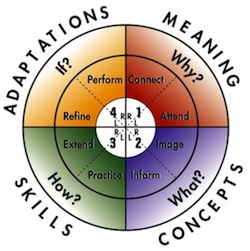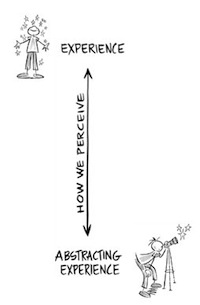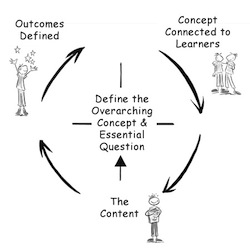
or Signup for a free trial
What is a 4MAT Lesson Plan?
The 4MAT lessons that are found on this site, are all built on a common instructional framework called The 4MAT System. 4MAT Lessons all share a number of features...
- They begin by captivating and inspiring learners by showing how learning connects to them and relates to their own lives. (The CONNECT step)
- They encourage student sharing and discussion and include methods for drawing students into discussions about how information relates.
- They uncover the essence, by helping learners see the big picture or how learning connects to the underlying content that teachers are asking learners to master. (THE CONCEPT)
- They let students take over, to be responsible for their own learning and to create something new in the world by using learning in some new and original way.
4MAT enables teachers to re-organize teaching to address these concerns. These changes in delivery will results in immediate and lasting improvements in student learning.
But 4MAT requires a new conception of how people learn—one that challenges the methods that educators use to deliver information.
It is just not enough to know what students should learn. Teachers must also consider How people learn. That is what 4MAT helps provide. Please explore these teaching designs and give us your thoughts and feedback. We look forward to your feedback and insights.
|
4MAT is a template for delivering instruction in a way that will appeal to all learners.4MAT is a cycle of learning that moves from learner engagement to knowledge acquisition to skills and fluency development, then to creative adaptation of material learned. By moving through this cycle, teachers naturally address all the needs of diverse learners. |
Perceiving
|
The 4MAT® Model explains learning in terms of the ways people perceive and process information.Perceiving Human perception–the ways people take in new information–occurs in an infinite variety of ways, all of which range between experience and conceptualization. Experience–Perception by personal engagement–sensations, emotions, physical memories; the immediate; the self. Being in it. Conceptualization–The translation of experience in conceptual forms–ideas, language, hierarchies, naming systems. An abstract approach to learning. Being apart from it. The interplay between the “feeling” of experience and the “thinking” of conceptualization is crucial to the learning process. It connects the personal values and perceptions of students to those of expert learners. |
ProcessingHuman processing–what people do with new information–occurs in an infinite variety of ways, all of which range between reflection and action.
|
Reflection – Transforming knowledge by structuring, ordering, intellectualizing. Action – Applying ideas to the external world; testing, doing, manipulating. The interplay between the “watching” of reflection and the “doing” of action is crucial as it provides the impetus for acting on internal ideas. It encourages the learner to test ideas in the real world and adapt what they learn to multiple and ambiguous situations. |
Learning Styles
|
Together, perceiving and processing describe the whole range of the learning experience. While all learners engage in all types of learning, most seem to favor one particular type…
Type One Imaginative Learning–Feeling and watching, seeking personal associations, meaning, involvement. Making connections. Key question: Why? Type Two Analytic Learning–Listening to and thinking about information; seeking facts, thinking through ideas; learning what the experts think. Formulating ideas. Key question: What? Type Three Common Sense Learning–Thinking and doing. Experimenting, building, creating usability. Tinkering. Applying ideas. Key question: How? Type Four Dynamic Learning–Doing and feeling. Seeking hidden possibilities, exploring, learning by trial and error, self-discovery. Creating original adaptations. Key question: If? |
Right Brain, Left Brain
|
We know, too, that learning entails interaction between the right and left brain.Left – Operates best through structure, sequence. Prefers language, is sequential, examines the elements, has number sense. Works to analyze or break down information. Right – Operates out of being, comprehends images, seeks patterns, creates metaphors, is simultaneous. Strives to synthesize, consolidate information. The interplay between right and left is crucial to higher learning and thinking. It provides a greater range and depth of understanding and encourages creative expression and problem |
A Cycle for Delivering Instruction
|
4MAT offers specific guidance for any teacher to teach anything in a way that will appeal to all types of learners. |
Assessing with 4MAT
|
4MAT offers teachers and trainers a guide for assessing learner growth through the course of a lesson. |
Concept Based Teaching
|
4MAT offers a concept-based framework for curriculum and instruction that focuses on...
|









